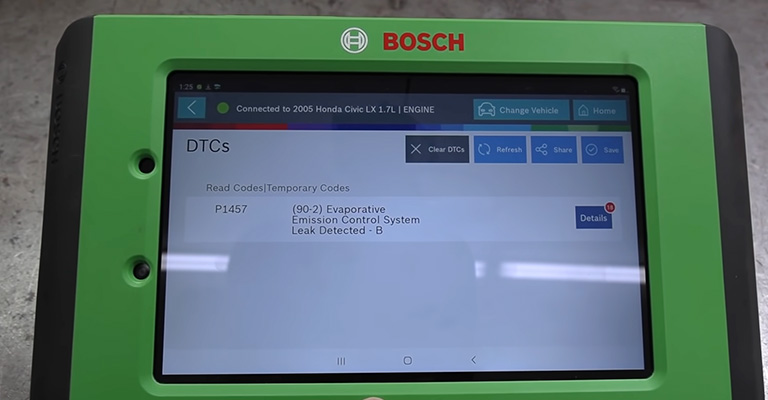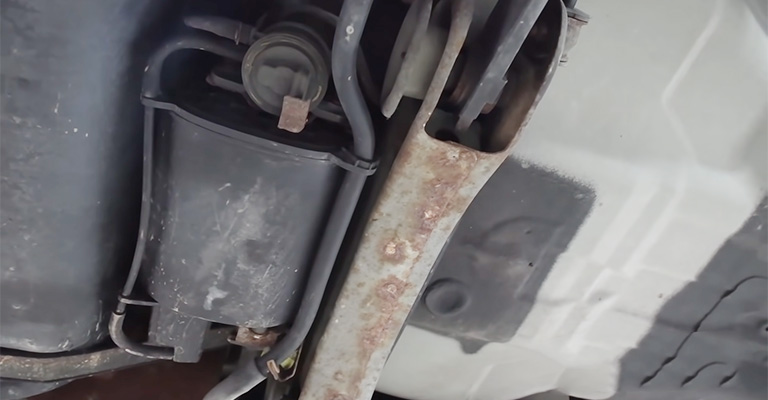The EVAP system is malfunctioning if you have a Honda with a P1457 OBD II engine error code. EVAP systems mostly work to reduce smog, but they can also affect performance and fuel efficiency.
P1457 indicates a leak has been detected in the evaporative emission control system. According to some scan tools, the problem is reported as a leak in the EVAP canister.
Under the car near the fuel tank, the vent valve on the charcoal canister usually causes the Honda P1457 code. Honda Accords, Civics, Odysseys, and CR-Vs commonly display this fault code.
An EVAP leak is detected by the onboard computer, and an error code is generated. Many factors can cause this, such as a bad charcoal canister, a faulty purge valve, a vacuum leak, a gas cap, and more.

Code P1457 Honda Meaning: Evaporative Emissions Control System Leakage EVAP Canister System
Whenever the P1457 error code is triggered, the ‘check engine light’ will illuminate. In most cases, you won’t notice any other obvious symptoms.
There are no engine or driving-related issues associated with this trouble code. The release of fuel vapors usually causes a foul odor.
Code P1457 Honda – What Are The Possible Causes?

Control of vehicle emissions is provided by the EVAP (evaporative emission prevention) system. A canister called an EVAP stores vapor from the fuel tank. As the vapor enters the engine, it is drawn into the intake manifold by the vacuum and burned.
As a result of this process, harmful materials are prevented from entering the engine, and the engine’s temperature is regulated. To operate the EVAP, two main parts need to be considered – the canister and the valve.
Two kinds of canisters are those with two-way valves and those with purge valves. Alternatively, the tank side is the area between the two-way valve and the fuel tank.
By separating the problem and its location, you can narrow it down more easily. For example, there is usually a small leak on the canister side of the EVAP, which causes the code to appear.
Leaks smaller than .02 inches in diameter will also trigger error code P1457. P0440 to P0457 is the EVAP system codes associated with larger leaks.
There are a few possible reasons why the error code appears:
- Vacuum lines around the canister are damaged or leaking
- A corroded vent valve on an EVAP canister
- There is a problem with the pressure sensor in the fuel tank
- Purge control solenoid defect
- EVAP canister that is broken or defective
- Fuel filler cap clogged with foreign particles
- There is a problem with the fuel filler cap not closing or remaining open
- The filler cap incorrectly used
- Fuel cap missing or damaged
P1457 Code Symptoms: What Are They?

Most of the time, a P1457 code results in a check engine light being illuminated because the PCM sets it. However, if the vacuum leak is large enough, symptoms like a rough idle may occur.
You may even experience frequent engine stalls. Your car might also emit fuel odors and smell like fuel inside the cabin.
In the case of these symptoms, other codes related to fuel or air metering are likely to present. Remember that leaks in the EVAP system may prevent you from passing emissions tests.
Inspecting A P1457 Code: How Difficult Is It?
There are a lot of components involved in the vacuum and EVAP systems, so inspecting the P1457 code can be challenging.
P1457 code issues should be handled by qualified technicians with prior experience inspecting EVAP systems. Fixing this issue on your own is not recommended since you could cause further vehicle damage if you misdiagnose it.
Thus, if the vacuum lines in the EVAP system cause the P1457 error, the technician will look to repair them.
A series of tests, ranging from voltage to resistance tests, will also be performed on the wiring in the system, after any damaged wiring is repaired or replaced.
Before ensuring the valve solenoid receives full voltage, the technician will check values related to the PCM and vent valve. Unless the readings meet the required standards, they will replace the valve.
P1457 Trouble Code: How To Fix It?

You can fix the problem by following these steps:
- Connecting the OBD 2 scanner is the first step. Take a look at the displayed trouble codes now. Then, start working on any code related to the engine or fuel system.
- After clearing the EVAP or fuel system codes, drive your car and scan it again. Here are the steps to follow if you still have the P1457 code.
- Ensure that the gas cap is present first. The next step is to remove it and see any cracks or damage. Finally, replace it if it is damaged or worn out.
- The gas cap should be cleaned if it is full of dirt and grime. Try scanning again now. If the code is still present, remove it, examine it for cracks, and clean it thoroughly.
- A worn-out or damaged cap is the most common cause of the P1457 code. It is easy and cheap to replace the caps.
- The EVAP’s canister side vacuum lines should be checked if the gas cap replacement doesn’t clear the code. Make sure there are no leaks at the connections and hose ends. Check for any hidden damaged parts while you’re at it.
- After checking the fuel tank, inspect the charcoal canister. Check for leaks or damage. Let’s say one of these parts is damaged. Because these components are difficult to replace, it’s best to seek help from a mechanic.
- Lastly, you need to check the vent valve for the canister. The leak can be caused by corrosion, moisture exposure, and contaminants. Again, replacing a damaged or old valve is the best option.
- The best thing to do is to take your car to a nearby mechanic if the code persists even after following these steps.
Is It Necessary To Replace The Gas Cap?

A P1457 fault code can lead to Honda owners replacing the gas cap. However, it is not typical for Honda P1457 codes to be fixed by replacing the gas cap.
P1457 Keeps Coming Back After Replacing The Vent Valve
You must perform a smoke test on your Honda if you have replaced the charcoal canister vent valve and still have the P1457 code. In the absence of leaks detected during the smoke test, the wiring and the ECU should be checked.
After Replacing The Canister Shut-Off Valve, Do I Need To Erase The Codes?
No. When the problem is fixed, the check engine light will turn off. In the next two driving cycles, the EVAP system will be self-tested. It will change from a current to a stored code if no problems are detected.
Here Are Some Tips About The P1457 Honda Code

- It will be necessary for you to work near the fuel tank. It is not recommended to use a heat torch for heating up and removing the bolt.
- Bad ECU EVAP circuits or wires can also cause the code P1457 on Honda vehicles.
- The Honda P1457 problem is typically not fixed by replacing the gas cap.
- Occasionally, the screws will break off when you remove the canister, and you will need to replace both the canister and the valve.
- The diagnosis of an EVAP system can be a challenging task. A smoke test should be performed to check the EVAP system for leaks to properly diagnose the Honda P1457 code.
What Can You Do To Prevent The P1457 Error Code?
Damaged or improper gas caps often cause P1457 codes and other EVAP-related issues. Make sure your cap is tightly closed after filling the tank to prevent these issues in the future.
Dirt, moisture, and other contaminants can also enter the fuel system through a damaged fuel cap. It is therefore important to replace a damaged cap as soon as possible if you notice it.
What Is The Cost Of Fixing P1457?
You can expect to pay between $70 and $160 per hour for P1457 error code repairs. It is important to take into account the time it takes for your vehicle to be repaired, the make and model of your vehicle, and the engine of your vehicle.
Can I Still Drive With A P1457 Code?
You may not immediately notice drivability symptoms with the P1457 code, but this doesn’t mean you should ignore it. The poor air/fuel mixture in your engine can further stress your engine, resulting in further damage.
Also, vacuum lines and fuel and air mixtures must regularly perform for your engine to run, so risking any issue with these systems is never worth the risk.
Is The P1457 Code Serious?
There is no need to worry about P1457. Your engine will not be affected, or drivability will be affected. P1457 is close to moderate on a scale of severity.
However, this problem could also cause poor gas mileage, engine misfires, and other issues with your vehicle. It is therefore recommended that you fix the problem as soon as possible before it becomes more costly.
Final Words
There is an issue with the EVAP system on a Honda Civic with a P1457 OBD II code. Charcoal canisters are the most frequent cause, but purge valves and gas caps can also cause it.
Also, a leak may exist somewhere in the line that is difficult to find. A smoke machine is used to locate leaks that are difficult to detect, feeding smoke into the EVAP system and exiting at the leak.

Leave a Reply